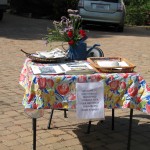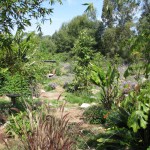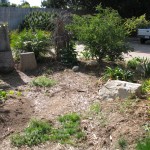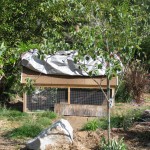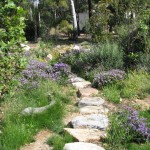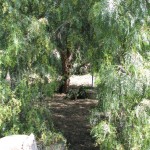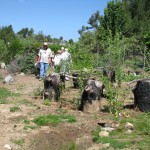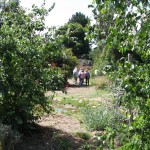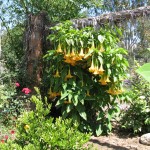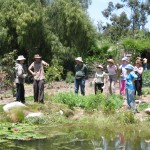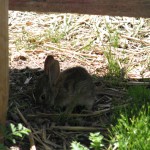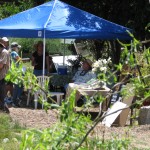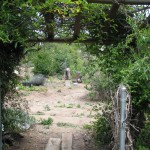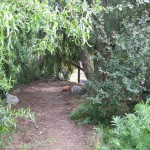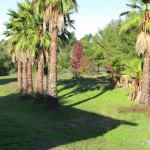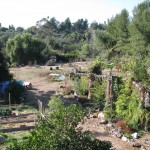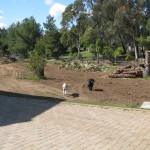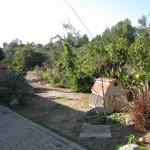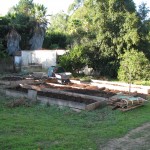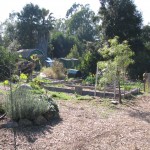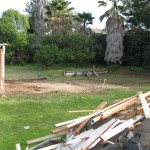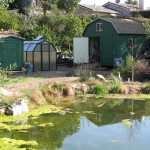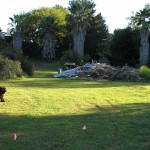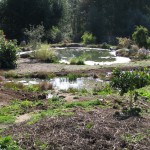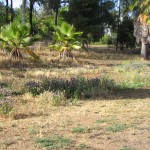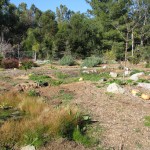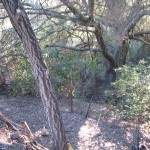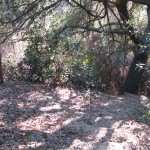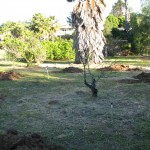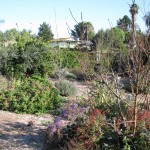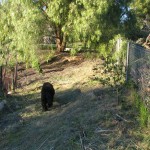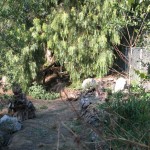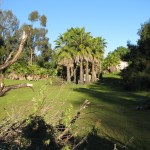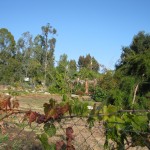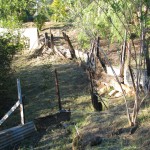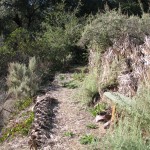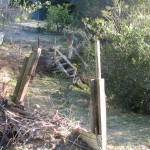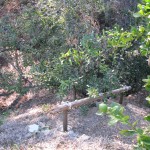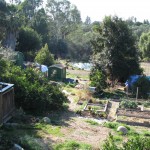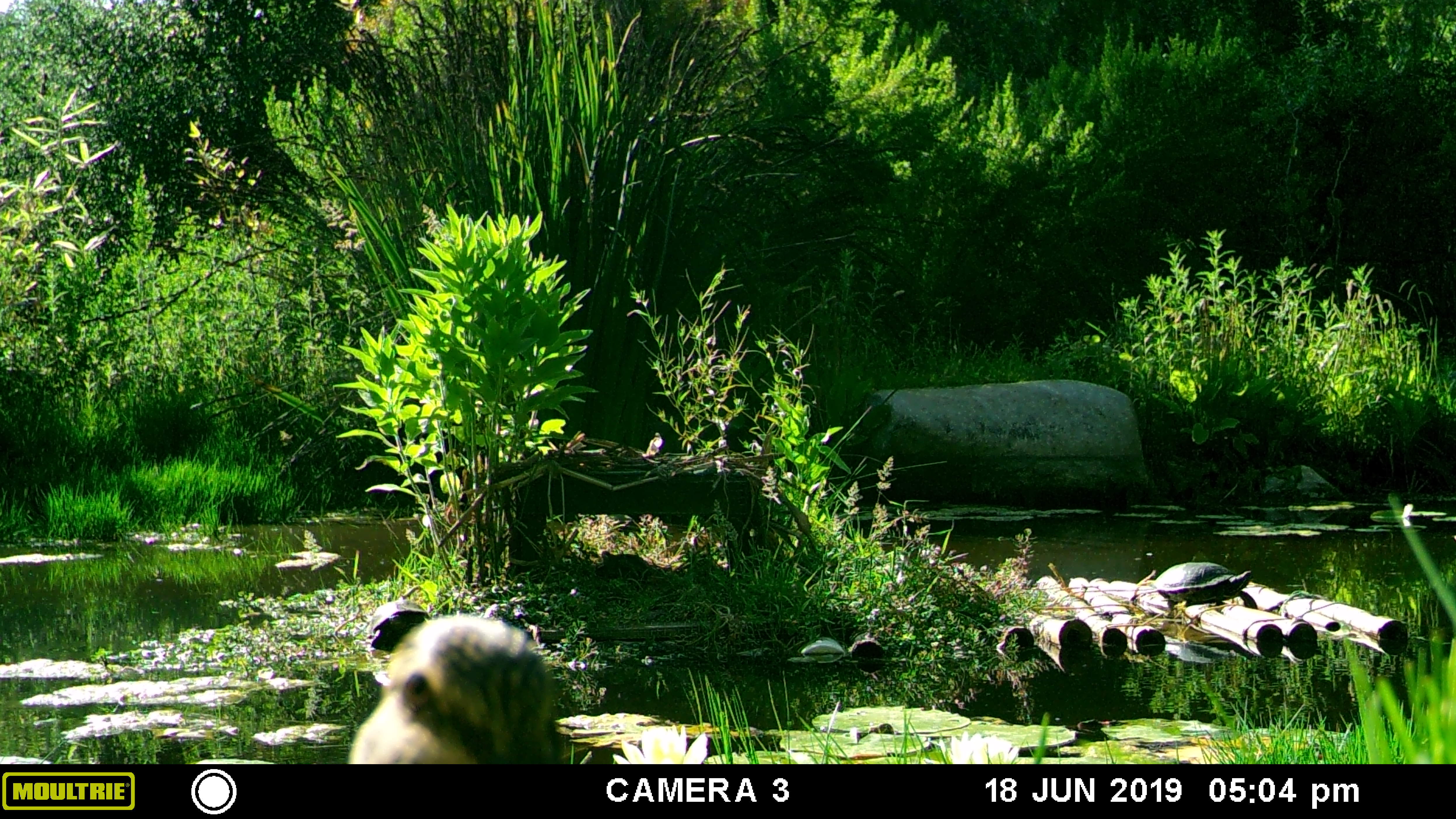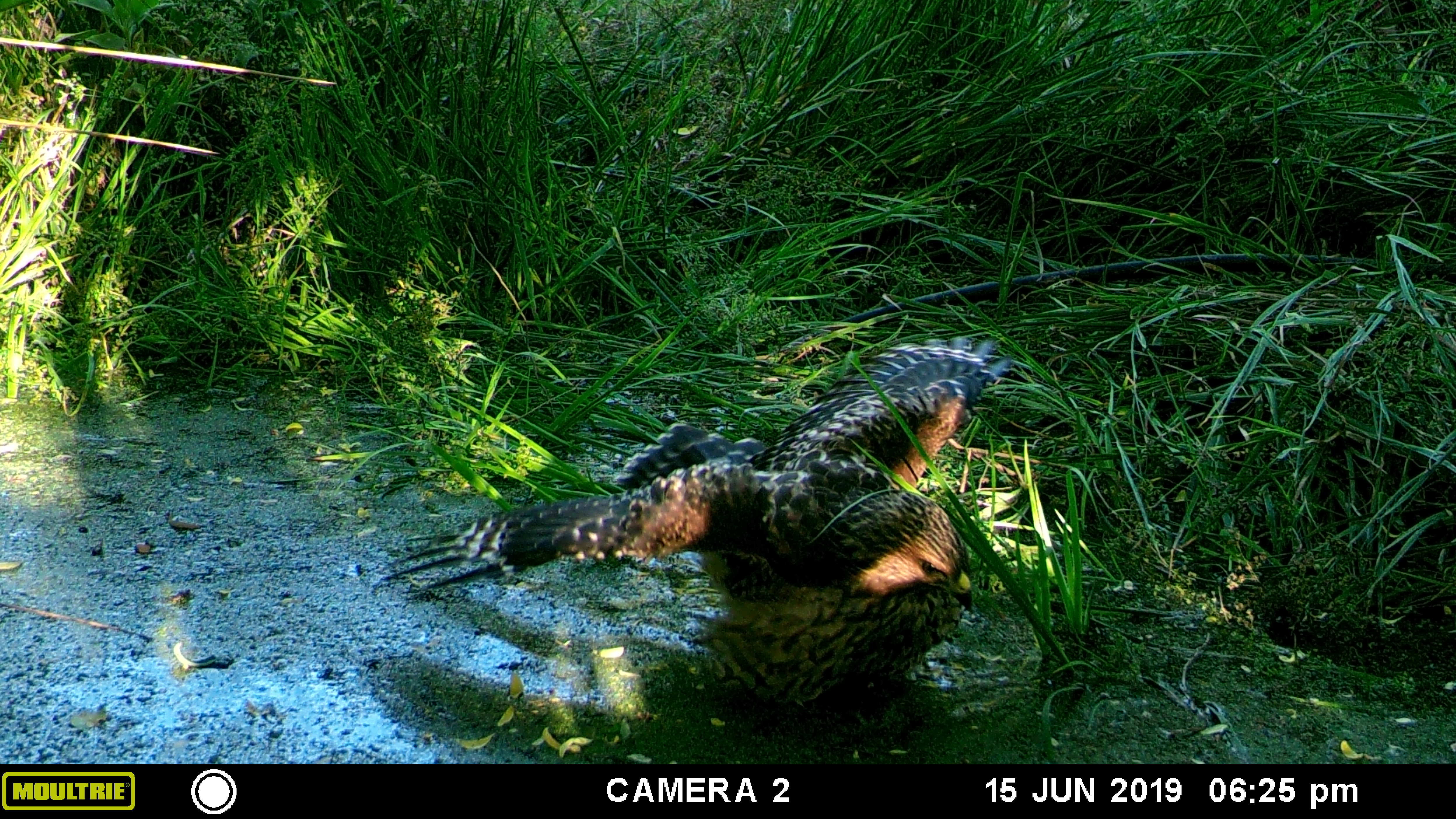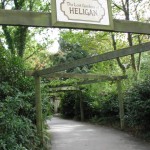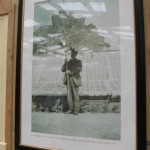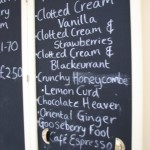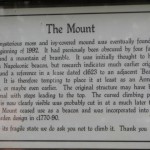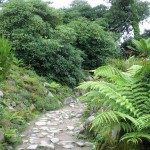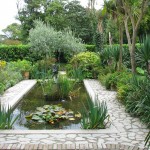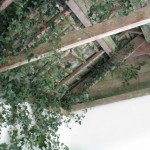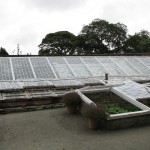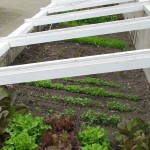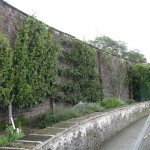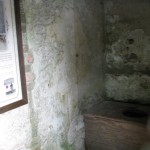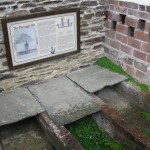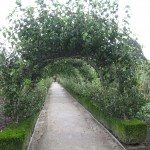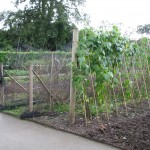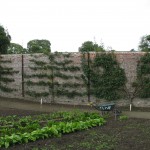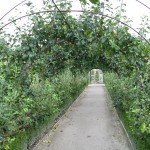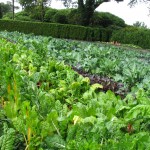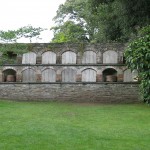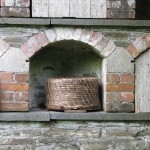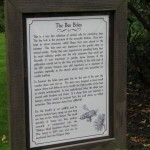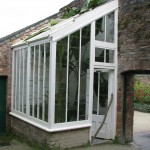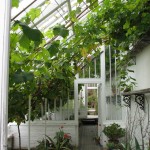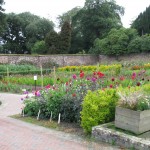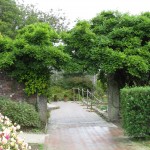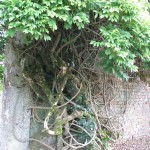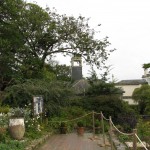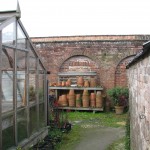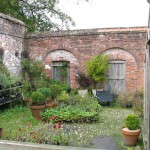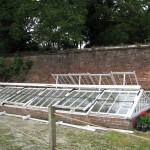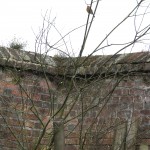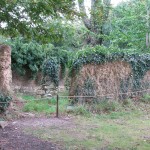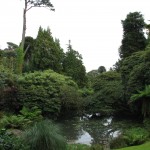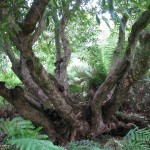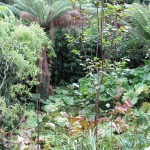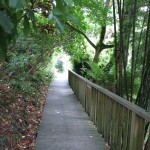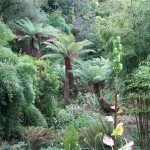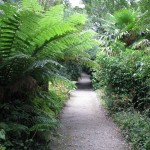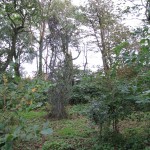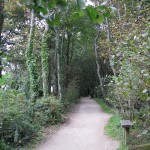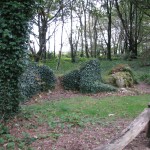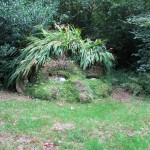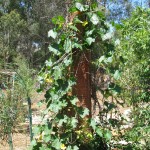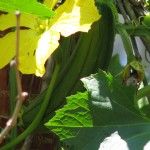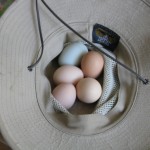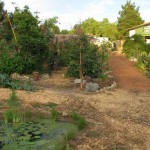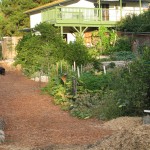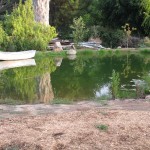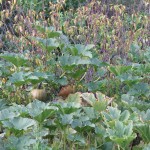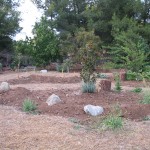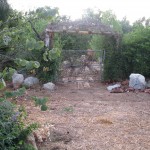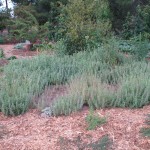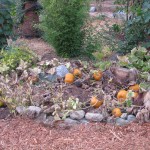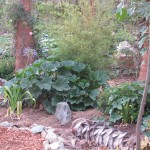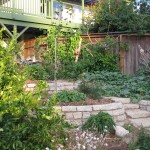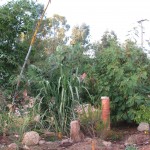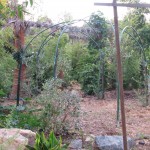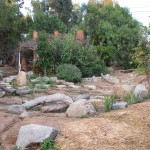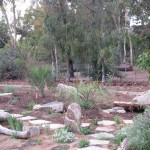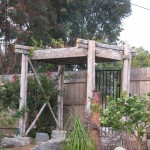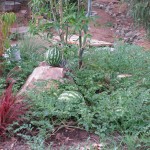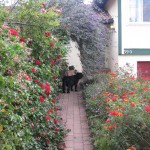- Animals, Bees, Birding, Chickens, Compost, Gardening adventures, Health, Other Insects, Permaculture and Edible Forest Gardening Adventures, Photos, Ponds, Quail, Rain Catching, Reptiles and Amphibians, Soil
I Went to a Garden Party….

AAUW Garden Tour Saturday was the AAUW Garden Tour. What a glorious day. I expected about a hundred visitors, and made 120 handouts. Sometime in the early afternoon I guess they ran out, and I didn’t know about it for awhile. I made 25 more for the last two hours, and have five left. One of the docents said that some had been turned back in during the morning. Every couple probably took just one… wow, that’s a lot of people.
I’d been talking to the garden all week, asking the blooming plants to hold that thought for a few more days, and encouraging the nonblooming ones to get a move on. The plants did what I asked! There were so many flowers out Saturday, it was amazing. Heirloom roses, Gideon’s Trumpet, ranunculus, herbs, wildflowers, and waterlilies. The garden, apparently, also was also all for proof in advertising, as in standing behind the NWF Habitat sign on the front gate. So many kinds of butterflies and dragonflies were out for the first time this year that people remarked on it. In the afternoon, there were sightings of a king snake all over the property; I think it had to have been three kingsnakes. One was moved from the refreshment area, but he came back, and then as I was standing by the pond talking to some ladies one came past us. Another was sighted up in the driveway. Roger sighted a gopher snake. No one shrieked or complained; either these were hardy people, or the idea that this was a habitat yard made them keep calm. It also backed up my claims of letting snakes deal with gophers and rodents! One man spotted a baby bunny under the Withy Hide bench. By one o’clock, it was funny. It was as if a button had been pressed to turn the garden on, and all the features were working! What a glorious day.
Jacob (Aquascape Associates) and Roger (landscape architect) and I answered questions for most of the day; the last four visitors left at four. So many people asked questions about permaculture, soil, beekeeping, cob ovens and rain catchment that I know that I couldn’t answer everyone’s questions. Of course there were some who like a tidy, orderly garden, and that is fine. If everyone came away with some idea how to work with nature rather against it, to use chemicals less, to grow organic food, to repurpose, to compost their kitchen waste and weeds, then what a lot of small ripples of good will come of it.
Thank you to my dear friends who helped prepare the garden so that it looked stunning. And thank you to the snakes, butterflies, bees, dragonflies, birds, bunnies and who-knows-what-else that came out to perform for the visitors! And thank you to everyone who visited! No casualities; all good.
Here are some photos, although my camera doesn’t do the colors justice:
AAUW Garden Tour Welcome! Look at photos of how it was. Main entrance walkway Walkway into the Nest One of the many trails A palm sitting stump between guilds by the driveway A green melon under variegated lemon, with native grasses. Quail hut, with privacy boards up. Status and wildflowers across the stone walkway Cool spot under the upper pepper tree Roger and visitors by the Withy Hide Some of the first visitors of many Pickerel blooming in the little pond Gideon’s Trumpet keeping blooms and aroma until the tour Jacob teaching about natural ponds Baby bunny under the Withy Hide bench Roger answering questions View from the Bee Garden gate Cool spot under the pepper tree -
The Duck Boathouse

Mallards in the pond Our large pond has been attracting many waterbirds. We’ve seen mallards, widgeon, shovelers, snowy egrets, greater egrets, green heron, great blue heron, plus fishers such as phoebes and a kingfisher. In fact one mallard couple has become brave enough to waddle near when I feed the chickens. I throw a little scratch out, and the ducks snack on that along with the grasses. The male, who my daughter dubbed John Drake after the Secret Agent Man series main character, stands nearby and scolds me for not throwing out scratch on demand.
Since the garden plants are within their first year they haven’t grown in. I thought how great it would be to continue providing habitat by having a duck nesting box. I began to search online but the ones I saw were incredibly expensive for what amounts to just a box. You could place them on shore, but they would be within reach of predators. Or you could connect them to a pole sunk into the pond.
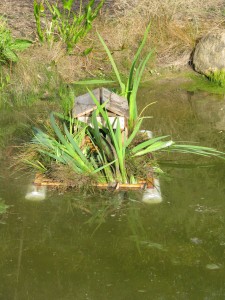
The front, with aquatic iris in front of the entrance. I broached Jacob with the subject and he was enthused, so he built one entirely out of scrap materials. I had a length of 4-inch PVC pipe with caps on the ends, which had come with the house. He used this as plastic pontoons for support. He tied on the side of a crib, built a little house out of a lightweight wooden crate I’d brought home that day which had transported potted plants, and dug up some of the plants already in the ponds to use as camouflage. The plants will live with their roots trailing in and helping clean the water. What came of all these recycled materials is just the cutest duck boathouse nesting box ever, I’m sure. I haven’t seen the female mallard for a few days, so she may be sitting on a nest elsewhere. I hope that a duck does enjoy the house, and if not, it is very fun to look at and is helping clean the water as it floats. What fun!

The back and sides, which will be hidden by plants as they grow. - Gardening adventures, Heirloom Plants, Permaculture and Edible Forest Gardening Adventures, Ponds, Soil
Finishing Flagstone

The task this morning: move and place flagstone and dirt. Today I finished cleaning up the disaster that I made when I dug out my upper pond (see Reponding). There have been piles of dirt, stacks of flagstones and rocks, and mess everywhere for two months too many. The reponding project is still not a complete success as the decomposed granite mixed with clay soil allows seepage in the pond. I have to keep filling it up, but at least it is with well water, and eventually I believe it will seal.
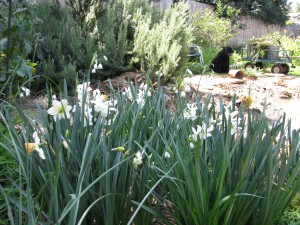
My faithful hound growing bored waiting for me past the heirloom daffodils. I didn’t want or need the same flagstone surround that I previously had holding down and covering the pond liner. I wanted a more natural look, but yet I had all this flagstone! So I completed the walkway around the pond, adding some overhanging flagstone under which the Pacific Chorus frogs may hide. One jumped out indignantly when I moved a rock. I did a little planting, and Jacob began to plant aquatic plants now that the season is beginning and transplants are possible. I found that the pond was full of mosquito larvae, and much to my surprise and joy, tadpoles! More mosquito fish were added. They are now lolling around groaning and holding their fishy stomachs with all the larvae they have (and still have to) eat.
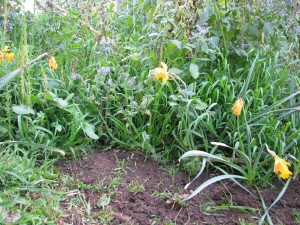
Moist soil and a tangle of flowers and weeds... magical. I made flagstone stairs through the overgrown embankment, for access to the bird feeders. The grass, borage, daffodils, weeds and wildflowers are so dense in there that as I was kneeling in the moist dark soil I felt as if I were in a Beatrix Potter book, or some other English garden story. It was magical and redolent of springtime.

A pathway up through an English children's story. When I finally placed or stored all the flagstone, I had great piles of dirt to contend with. Some I carried in buckets over to the side yard where I’d placed some flagstones. That got old pretty fast. I only carried them full twice, then only filled them 3/4 full for the rest of the trips. My arms are a little longer now. I really didn’t want to haul wagonfulls of dirt down to the lower property again, so I stood and thought about what I could do. Then I spotted leftover scalloped edging bricks and decided to use them and the soil to make another garden bed. Why not? I can always take it out. It sure beat hauling all that dirt out of there this afternoon!
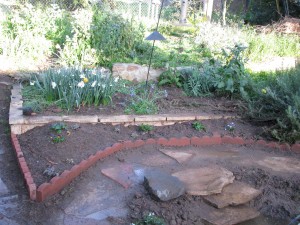
Have extra dirt and edgers? Make a new bed! Finally I was able to plant some herbs and flowers I’d purchased for this area. Violas and violets, two of my favorites! I’ll plant seeds another day. I’m hoping all this newly moved dirt won’t wash into the pond when we have our predicted heavy rain this weekend. Maybe I’ll cover the new beds, just in case.

Violets and violas... big favs. I watered everything in, which caused mud to scum up the newly swept flagstones (grrr!), filled the bird feeders (it is Project Feederwatch count days Thurs. and Fri.), and closed the gate on this project (for now!). Once again, I shall have no trouble getting to sleep, but probably some trouble getting up in the morning!

A touch of flagstone and rock; plants will fill in. 
Finished! - Animals, Bees, Birding, Chickens, Gardening adventures, Heirloom Plants, Other Insects, Permaculture and Edible Forest Gardening Adventures, Photos, Ponds, Rain Catching, Vegan, Vegetables, Vegetarian
Garden’s One Year Anniversary
Happy Anniversary! One year ago on Feb. 1, 2011, I signed a contract with landscape architect Roger Boddaert (760-728-4297) to create a permaculture garden. For twelve years I’ve had this sloping property that was covered in weeds and worthless Washingtonia palms. Not only do these 2 acres slope down to a barranca, but it was filled in due to catching all the rainwater that runs from the street and properties above. I have to give credit to friend Gary B., who brought up the subject of permaculture in a conversation the year before. I’d heard the term and thought I knew what it was about, but months later when I was researching what to do with my property I remembered him mentioning it, and looked it up. I found what I was looking for. I’ve been an organic gardener for many years, have owned chickens for their eggs, have refused to till the soil so as not to kill microbes, have worked naturally with animals and plants, have created habitat, composted, recycled, collected rainwater… and all of that was permaculture. And so much more. How can one not be attracted to the term Food Forest? Certainly not a foodie and gardener like myself.
What happened on the property starting the week of Feb. 1 for the next six months altered the land so that it is truly two acres of habitat. It is useful, it is natural, and it is beautiful. Roger’s team led by Juan built beautiful walls of urbanite, planted and hauled, worked in scorching sun and frosty mornings and made what was dreamed into reality. An integral part of the garden has been diverting the water from erosion points and into rain catchment basins and natural ponds, and that is where Aart DeVos and Jacob Hatch of Aquascape (760-917-7457) came in. They also installed the irrigation. Dan Barnes did the rough and the precise tractor work (760-731-0985) and I can’t recommend his experience and skill enough. Fain Drilling dug the well (760-522-7419) and the wonderful sheds were built by Quality Sheds of Menifee (http://www.socalsheds.com) .
Along with some volunteer help from Jacob, I am the sole caretaker of the property. I am planning the plant guilds, weeding, improving soil, moving problem plants and trees and, did I mention, weed? Oh yes, then there is weeding. On Saturday May 12th, the garden will be on the Garden Tour of the Association of University Women of Fallbrook, and hopefully many people will be inspired to go organic, to create habitat, conserve water and grow extra food for the Fallbrook Food Pantry. We’ve come a long way, baby!
The following photos are comparisons between the precise location last year at this time, and today.
The property last February. The property today. Sophie and General loved all the excitement. They love the new gardens and pond even more. My veggie beds with the old sheds behind. My veggie beds with the new sheds and greenhouse behind. Where the big sheds were: everything usable was reused. New sheds that aren’t a safety hazard, and the greenhouse. The lower area with shed debris (lots of mowing area!). Hey, there are ponds there now! Not much for the neighbors to look at. Quite a lot for the neighbors to look at! Access to the old oak was hazardous. Palm stairs lead past the oak to a birding area. Stonefruit were old when I moved in. New stonefruit adorn what is now the Bee Garden. An erosion area sloping down to the barranca. Water won’t flow through here anymore. Lots of mowing and palm frond removal. Not so anymore. Horrible looking debris failed to hold back the embankment. Palms were used to stabilize the new paths and camoflage the supports. Old unstable stairs led to washout areas. New railings, stairs and urbanite retaining walls lead to another viewing area. The view from my balcony. Part of the old shed remains. Hey, there’s a pond there! -
Re-Ponding, Part 3

Filling it up (that's a hummingbird decal on the window, not a giant hummer!) Just in case you are breathlessly awaiting the next installment of the re-ponding project, I’ll alleviate the suspense. The pond is now shaped as I would like it, with a nice flat shallow end towards the back and a kidney shape. Later I’ll add more contours around the edge so that the parts aren’t rounded; that will not only give it a pleasant shape, but give it more edge, which is much safer for the survival of tadpoles.
By cutting into the irrigation, the pond can be fed with well water instead of domestic water which is not only less expensive, but much healthier. Allowing the water to run down the sides and kneading the clay by hand washes the fine clay particles into the pond. There they can settle and seal the sides.

There is lots of clay in this soil! Every few hours I stirred the pond so as to stir up more clay and have it resettle on the sides.
Now I’m allowing the water level to go down to see if any part of the pond has sealed yet. When the water stops disappearing, I’ll know the bottom and some of the sides are already sealed. This cold weather has made me a little hesitant to be working in the water… brrr! Because of that the pond will probably not be done this week, but I’m working on it.

Stirring up the reddish clay. If sealing the sides with clay in this manner doesn’t work, then I’ll need to separate clay out by hand and mash it onto the sides, kind of like making pottery. That will definitely have to wait until later this week when the daytime temperature rises! Meanwhile as the water sinks, I’m weeding, transplanting, weeding, composting, hauling, and did I mention weeding?
-
Re-Ponding: Changing a lined pond into a natural pond

Draining the pond with a hose syphon. The little upper pond which my daughter and I laboriously created about seven years ago has finally come to the end of its life. Home to dragonflies, mosquito fish, snails, and some interesting black flatworms, and having provided habitat for snakes, birds, mice and frogs, this lined pond has been beautiful and most satisfactory. Having been given the black flexible pond liner sheet, a lot of very heavy flagstone and some stones, we had cut down a juniper, dug out the roots in heavy clay and rocks, shaped the earth into ledges for nursery pots of waterlilies, and leveled the edges. Everything I read about ponds said to put gravel into it, so against my better judgement I did, and immediately regretted it. The gravel prevented me from walking barefoot in the pond, was a danger to the liner, made walking on the ledges in boots very slippery, and has trapped sediment and roots (end of anti-gravel rant). The pond was aerated by a series of very expensive pond pumps, which trickled water down a little waterfall and impacted my electric bill. This pond was a maintenance problem; I would pull out the algae (carefully picking through it to save trapped fish, snails and dragonfly larvae), but the waterlilies got the better of me. I had no idea that they would grow so huge and disgusting underwater. (See my post The Monster in the Pond, March 2, 2010.) Anyway, after the last pump died this summer, and after the enormous success of the two natural, unlined ponds Aquascape created for my permaculture gardens, I decided that I would change this pond into a natural one.
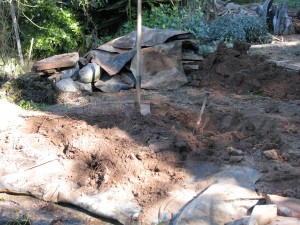
Digging a shallow end for the pond. This area is also the one in which we do our Project FeederWatch bird count for Cornell (http://www.birds.cornell.edu/pfw/), and was our original National Wildlife Foundation Wildlife Habitat (http://www.nwf.org/At-Home.aspx ), which now has extended to our entire property. I wanted a shallow end to the pond with planted waterplants that would clean the water and provide shallow habitat for all the Pacific chorus frogs that come up in late January to breed in the pond. In fact, they’ve been croaking their way up the property already, so now I’m in a rush to get the pond finished for them.

The liner was covered with a mat of plant roots and gravel. Once again I found myself moving large pieces of flagstone and rocks, although I’m seven years older than I was last time, and my back let me know it. Then began the draining of the pond. I tried to start a syphon the way I do to clean my fishtank, by sucking air through a hose and very, very quickly dropping it before I sample the water. I couldn’t get it started. I did get an interesting circular red mark on my lips, which I had to explain that afternoon at my dentist appointment. The difference in elevation between the top and bottom of the hose was not great enough, even though we put together all our hoses and strung them out down the property. I tried to fill the hose with water, but it didn’t work. A phone call to the pond expert, Jacob from Aquascape, made me slap my head with an exclaimed, “Duh!” He recommended attaching the hose to a spigot, sending water through to the pond to fill the hose, then removing the end from the spigot. The water would flow back and the vacuum would start the syphon. Probably everyone in the world knows this, and I knew there was something about attaching a hose that I should do, but couldn’t figure out. Anyway, it worked, but the syphon was a trickle. After many starts and stops, and running back and forth up and down the property, my daughter and I discovered in the morning that the syphon had worked, and almost a quarter of the water had drained. I kept restarting the syphon, until only about a quarter of the water was left. The aroma of the sludgy water infiltrated the house and the yard. I made a fire in the fireplace figuring that for once the smoke was a good thing!

The monster in the pond, revisited. My dear daughter, before returning to college, tackled that monster in the pond. The waterlily was so huge and slippery that she managed to break pieces off but not pull the whole thing out; in fact, she was in danger of being pulled in by it!

Saving water lily chunks to make new plants. Today, with Jacob’s help (actually, he did most of it!), we pulled all the lilies out of the pond. The root systems of the three, which had outgrown their meager nursery containers years ago, just about filled the bottom of the pond. I scraped gravel up with my rubber-gloved hands and then began scooping the remaining water and sludge out with a bucket.

An egret looks hopefully into the sludge. I threw the water onto the plants, and then when the sludge of decayed algae, plant material and soil became thick, I poured it over my bulb beds as a fertilizer. There may be a high concentration of salts in the muck, but the nutrition value should be wonderful. And it makes the ground around my bulbs a lovely black color!

Sludge makes good fertilizer! I almost finished, half-bucketful at a time, hauling water up and out of the pond and onto various areas of the garden, and indeed I meant to finish.

Scooping sludge into a bucket. But with about an inch or more of sludge to go, with yet more gravel to scoop, my body said, “Nope! You’re done!” I also had missed breakfast and had only snacked today, and had been exercising, hiking, planting and weeding for the last few days so I told my self that I had a decent excuse to stop. I took a long hot bath to soak the splashes of yuck off of me, and will continue into the muck and mire tomorrow. Stay tuned!

Our fat cat Pippin, who has nothing to do with this story! -
First Rain
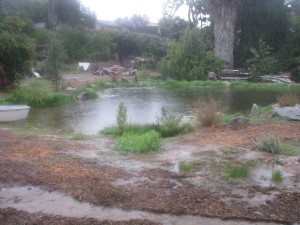
Rainfall on the pond The first week of October and we’re having a day of heavy rain… almost unbelievable. Normally October in San Diego is high fire season. The brush is crisp from months of drought and high temperatures, and then the Santa Ana winds begin: wild dry winds that blow east to west from the deserts, full of static and mad gusts that turn brush fires into firestorms.
My property is a watershed, funneling rainwater from the street through to the streambed in the barranca below, taking all my topsoil and some of the embankment with it. This year I had the beginnings of a permaculture garden installed to remedy this pattern. By deepening the loam and placing berms around plant guilds water is encouraged to pool up and soak in rather than run off. Overflow is channeled through a series of dry ponds which allow water to soak into the ground. From there it is channeled safely down to an overflow into the stream. Today was an early test of what has been worked on since Feb. 1.
The tilling, mulching and berming done by the crew of landscape architect Roger Boddaert proved successful.
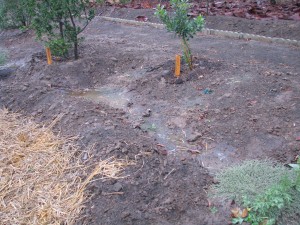
Berms hold water back so that it may soak into the loam The soil has a high clay content, which was good news when digging the large pond because it held water without a liner. It is bad news for other areas of the garden where water is pooling up instead of sinking in. I was able to take note of these areas this afternoon so that they could be drained and mulched for more absorption.
Aquascape, the company that installed the series of ponds, is still planting and maintaining the waterways. Jacob came out in the rain and watched it flow, shaping and fortifying as the force of the rain and thus the volume increased.
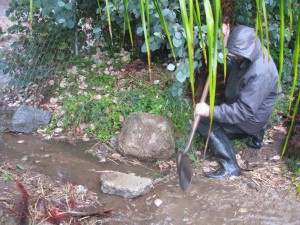
Jacob helping water flow Water flowed under the fence from the street, but instead of flooding a cement culvert as it used to do, it is channeled down to the ponds.
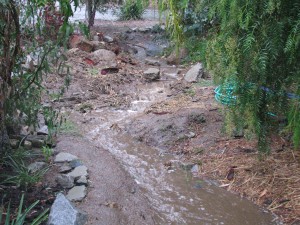
Street run-off enters under the fence 
Blocked by debris, water floods past the bridge Silt and debris blocked water flow under the bridge, and was eroding the area by the structure called the Nest. I cleared the debris and raked rocks and silt to the weak side, and that fixed the problem temporarily.
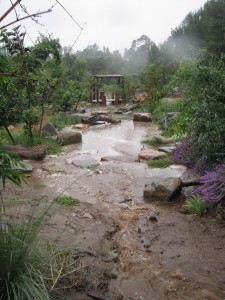
Rainwater flowing into the first 'dry' pond Water quickly filled the first dry pond; with the high clay content, water percolates but does it slowly.
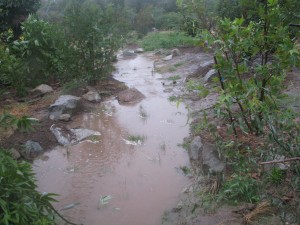
'Dry' ponds filling and slowing run-off 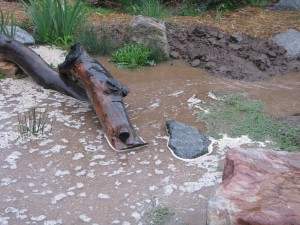
Logs and rocks are ornamental and slow water flow 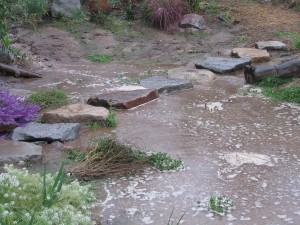
Normally dry, the stone crossing is now almost underwater 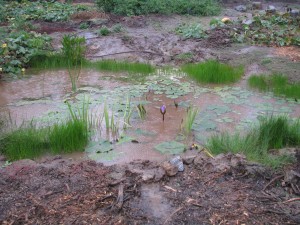
The little pond is rapidly filled. As water reached the small pond, which wasn’t intended to permanently hold water but the clay had a different idea, the sides had to be shored up and the overflow diverted.
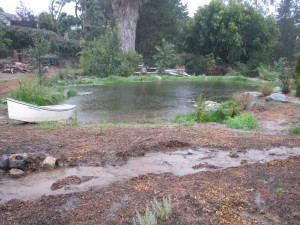
Water is diverted from the little pond around the big one Extra floodwaters aren’t being diverted into the large pond because we don’t want it filled with silt, and we don’t want it overflowing rapidly and eroding the sides. Instead the water flows through a channel around the large pond, then down to a prescribed place to flow out and over the embankment to the stream below.
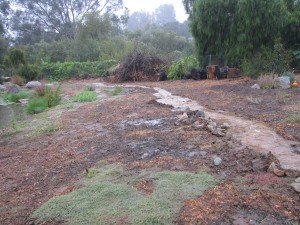
Overflow is channelled past the ponds and out to the natural stream below Some areas of heavy erosion had been filled and supported, and as of six this evening they looked wet but not iffy. What a night of heavy rain will do, I’ll have to see in the morning. I am very lucky to have this type of
rain early in the season. It has been heavy enough to cause significant water flow to help shape the watercourse and show weak spots, and the rain will be reduced to showers tomorrow then clear up, so repairs and improvements can be made before true flooding happens later in the year or early in the next.Although much more water is being held on the property, and topsoil is not being lost, it still pains me to see so much rain channeled out to the stream. Rainwater is a neutral Ph, and carries nitrogen (especially when
there is lightning). It is the best possible water for plants, as well as for human consumption and bathing. In side-by-side comparisons with tap water, plants watered with rainwater flourish far beyond the growth of the others. I’m greedy to hold that water onto my property, letting it soak as deeply as possible for tree roots to use far into the year. As the newly planted trees grow, their roots will help hold water and soil. As their leaves drop the mulch levels will raise, aided by compost and mulch that I will be constantly adding, and the soil will become more absorbent farther down. Each rain should have less runoff and more absorption. This rain has shown a great success with the garden, but I know it is only the beginning. -
The Lost Gardens of Heligan
If you ever go to England, go to Cornwall and spend at least a day at the Lost Gardens of Heligan (http://www.heligan.com/ ). Due to a flat tire we only spent four hours there and we didn’t see even half of the 400 acres of incredible restored gardens. The story is this: a thousand acres on the southern coast of Cornwall has belonged to the Tremayne family for about 400 years. At the end of the 1800’s, one of the Tremaynes had built extensive theme gardens. There were walled gardens, enormous hedges, glass houses, cold frames, a pineapple pit where the only pineapple grown in Cornwall grew warmed by horse manure. Melon houses, leisure gardens, formal flower gardens, woods, kitchen gardens and unbelievably, tropical gardens, filled the estate. Due to Cornwall’s position by the English Channel the climate is such that with care tropicals can be grown there. The estate was fantastic; then came WW I, and almost half the family and staff were killed. The gardens were abandoned. Subsequent wars and taxes took their toll, and the gardens became overgrown. Vines, brambles, trees and weeds ran rampant, breaking through the glass roofs, pulling apart brick walls, upsetting carefully laid pathways and covering every trace of the gardens under a head-high blanket of tangled, thorny brush.
Twenty-one years ago, the Tremayne who inheirited the gardens, asked one of the founders of the neighboring Eden Project ( http://www.edenproject.com/ ) to try and restore the gardens. The task was phenomenal and reads like a mystery. Hacking through the overgrowth they found the walls, the foundations and the clues as to what had been. Since then the gardens have been restored. They are everyone’s dream of a garden combined. There is a mound that was a beacon mound during Nepolianic times, but then discovered dates back to the Armada, and then back to Medieval times! There is a jungle with massive gunnera plants and palm trees, about half an acre of vegetables all grown from seed that dates from the late Victorian time, walled flower gardens, ‘antique’ poultry and cattle, unique sculptures recently added, and a wildlife garden to encourage the existence of so many insects, birds and animals that are disappearing. Even with weeding through photos I came up with so many that I want to share, that I’ll just post them below. Visit the website and read up on the Lost Gardens, voted Britain’s Finest Gardens. They are magical.
Entrance to a magical world. The Tremayne who built the gardens holding a single Gunnera leaf in front of his famous pineapple pit. Flavors of ice cream… we didn’t get to have any! A mysterious mound was uncovered and thought to have been a beacon site in Nepolianic times, and for centuries beyond that. Stone steps into the ravine The Italian garden Ivy coming through the roof, trying to reclaim the building once again. Hot houses and cold frames Cold frames for veg. Espaliered pears of many varieties. Writing on the wall of the ‘thunder room’, or original composting toilet All plants and veg grown are from the late Victorian period Espaliered fruit trees make use of warm wall space About a quarter acre of mixed greens. Bee skeps (baskets, pre-movable hives) were kept in boles for winter protection. A bee skep in a bee bole History of the Bee Boles A banana grows in Cornwall! Melon houses Potting shed with greenhouses in a walled area. Sigh. Cold frames in the potting shed A robin watches, just like in The Secret Garden The overgrown remains of mud brick walls A very steep pathway lined with chicken wire to prevent slipping The Jungle A wire sculpture of a woman with her arms out… can you see her? A deciduous walkway Mud Woman A very green man - Chickens, Gardening adventures, Heirloom Plants, Permaculture and Edible Forest Gardening Adventures, Photos, Ponds, Rain Catching, Vegetables, Vegetarian
The August Garden
Plants have been enjoying the beautiful weather and the constant irrigation from the well, and the garden is flourishing. So, unfortunately, is the Bermuda grass, but that is another tale. Since I see it everyday I don’t notice the change so much, but when I show someone around I am thrilled all over again with the incredible change that has happened on this property. There are so many birds, insects, reptiles and other animals either already here or scouting it out that I know the project is a success. It is a habitat, not just for me and my family, but for native flora and fauna as well. It wasn’t so long ago that I had a cracked, weedy asphalt driveway, a termite-ridden rickety porch that needed pest control, a house with a stinky deteriorating carpet and old splotchy paint, a tile kitchen counter with the grout gone in between and a cleaning nightmare, and a yard full of snails, weeds and Washingtonia palm trees, with the embankment eroding each rainfall. Over the last four years we’ve survived some pretty intense construction projects (none of which were done on time, no matter what they promised!). My house still has some repairs that need to be done but I no longer am embarrassed to have anyone over. The garden is wonderful to walk in and explore. I’ve taken some photos this evening to show you how things are growing:
Bees enjoying purple coneflowers The luffa squash has mighty asperations. A luffa squash and bloom. They are edible small and green, but I’ll leave them to dry. Five eggs today! Each laying hen participated for the first time! The little girls have grown up. The small lower pond and the palm pathway. The veggie bed. Rushes, fleabane, waterlilies and other plants are growing in nicely around the big pond. The boat is still on loan from Aquascape. A pumpkin tree? This apricot isn’t healthy, but the pumpkins sure are. These bare areas I’ll fill with plants that will make up guilds, each plant filling a niche to help the others grow. The entrance to the bee garden. Native vinegar weed loves a place we left untouched, and so do the bees. Sugar pumpkins ready a little early for Halloween. A feral zucchini, still producing at least one a day. Melons, passionfruit, pitcher plant and many others under the back porch we call the Poop Deck. Very eager bamboo, sugarcane and hops. Olive trees tied to painted PVC pipe to make a hut. The ‘Nest’ beyond the dry stream bed. A thud and a swish… with no warning the neighbor’s tree fell across the fence. A green roof for the entranceway, just beginning to show. The watermelons in the vegetable beds were tiny… these monsters are wild. That one grew on the rock on its own. Entranceway flower tunnel… with dogs waiting to go inside! -
The Importance of Leaving a Mess

Animal tunnels through a brush pile A clean yard is usually a pleasing sight. Picking up loose boards, plywood, sticks and logs keeps people from tripping, is encouraged by the fire department to reduce fuel for fires, and makes for more room to walk. Also, things live under debris and we’ve always been told to not poke our fingers into dark places (excellent advice! If a giant stuck his huge finger into our bedroom window we’d try to hurt it to make it go away, too!), and by eliminating so-called debris we reduce the chance of bites by snakes, spiders, or whatever bitey things may be living in your part of the world.
However, by reducing the debris, we also reduce habitat. Those bitey creatures need a place to live, as do the non-bitey creatures we are also displacing by removing wood. All these creatures are part of the intensely woven food web that keeps our planet populated and working. I cannot disagree about making your yard safe for children and pets, but if you have a space, make an area for habitat, too. Rope off a corner of your yard and tell your children and pets not to go into there, and leave bundles of sticks, pieces of plywood, old logs, piles of leaves, etc. in that corner. This is a home for the wild things, and your children can understand, observe and respect the fact that the world should not be made clean for them. Teach your children not to hunt and catch wild things, not to tear apart nests and destroy habitat. Observe and wonder instead.
In my yard, especially since I’ve had some sheds removed (in which racoons, wasps and possums raised families… I’m hoping to make a new place for them), I have stacks of plywood and old buidling materials which are good for recycling back into projects around my house. A junkheap, yes; a goldmine, yep. Under these stacks I have found such wonderful creatures that I didn’t even know came into my yard (perhaps they didn’t until the wood was left out).
The most exciting creature was a female Western pond turtle.

Female Western Pond Turtle In Washington, the Western pond turtles are endangered, and they are considered threatened in Oregon and are becoming rare in California and Baja California. Besides loss of habitat and an increase in pollution, one of the major factors in our native turtle’s slow demise is the release of non-native aggressive species such as the red-eared slider turtles. Red-eared sliders are America’s favorite pet turtle although they are native to the Southern United States. Due to releases they are everywhere. DO NOT RELEASE YOUR PET INTO THE WILD! As much harm has been done by and to domestic animals and wild animals by the releasing of pets as by habitat loss. A number of years ago there was a salmonella scare allegedly traced to pet turtles. The public’s response was to dump their children’s turtles in any waterway close by. Red-eared sliders have a distinctive red line by their eyes, and are named sliders because that family of semi-aquatic turtle can slide into the water quickly. They are omnivorous, aggressive, adaptable and become large. They eat anything that they can fit into their mouths, including the less aggressive smaller Western pond turtles.

Females have flat plasterons; notice her left stumpy leg. Finding a female Western pond turtle in the yard was fantastic, and I can only surmise that she had made her way up from the shallow streambed below the property to hopefully lay eggs. I haven’t found signs of a disturbed area yet where she may have layed, but am keeping the whole area protected just in case.

Long tails She is missing one front foot, probably bitten off while a youngster when something was trying to eat her. Before we knew she was a she, we thought of giving him a piratey name due to the missing foot and her semi-aquatic nature. Captain Blood was too fierce, but the author of that and other swashbuckling tales which had been made into movies is Raphael Sabatini. Now that is a terrific name. Go ahead and say it to yourself. See? So he became Raphael Sabatini until we checked her plasteron (the underside of her shell) and realized that it was flat not concave, which meant that she was a female. Males need concave plasterons so that when they are, um, amorous, they don’t fall off so easily. So she became Mrs. Sabatini. Long story… sorry. Nothing simple in my life. Anyway, we checked out Mrs. Sabatini’s health, and then released her into our small upper pond, which has an excess of mosquito fish and bugs, so that she wouldn’t be hurt with all the work that is being done down where she was found. We haven’t seen her since, so hopefully she is healthy and happy.

Good-bye Mrs. Sabatini! Under another piece of plywood I’ve found blue-tailed skinks (I couldn’t take a photo because they move too quickly), California Slender Salamanders,

California Slender Salamander gopher snakes, king snakes,

California Kingsnake and Pacific chorus frogs.
In a brush pile there are many birds hopping through, especially California towhees, Western fence lizards, alligator lizards, tree rats, mice and many other creatures.
In the ground are insects that you’d never expect. For instance while weeding one of my heirloom bulb beds I disturbed this huge caterpiller that had a horn tail.

White-lined Sphinx Moth Caterpiller The only horn tails that I’m familiar with are the tomato hornworms, but this guy was far away from my veggie patch, and instead of stripes had spots. We looked him up, and he is the caterpiller form of the White-Lined Sphinx Moth, also known as the hummingbird moth because of the way it hovers in front of night-blooming flowers to drink nectar. It is one of the important nighttime pollinators which few ever see. We put him back and left some weeds in for him.
Of course mason bees, among other pollinators, use holes in wood in which to nest. Some bumblebees nest in abandoned gopher holes, and they are the natural pollinators of many native North American plants such as blueberries (honeybees were imported from Europe with white settlers; until then native plants developed their flowers to attract and accomidate bumblebees, wasps, and hundreds of other native insects.)
All around my property there are logs and brush piles, and plywood layed down to choke out weeds in my veggie garden. Underneath there is a world of habitat. Isolated refuges for animals and insects who desperately need places to feel safe. So go ahead, throw down some mulch, some logs, a pile of sticks or some plywood. Know that you are doing the Earth a favor.

